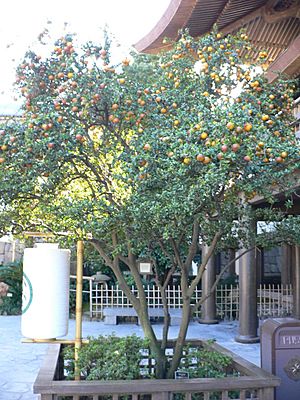Daidai facts for kids
Quick facts for kids Daidai |
|
|---|---|
 |
|
| Scientific classification | |
| Kingdom: | |
| (unranked): | |
| (unranked): | |
| (unranked): | |
| Order: | |
| Family: | |
| Genus: | |
| Species: |
C. ×daidai
|
| Binomial name | |
| Citrus ×daidai Siebold ex Hayata
|
|
The daidai is a special type of bitter orange that comes from Asia. It's known by different names, like gwanggyul in Korean.
This interesting fruit first grew in the Himalayas. From there, it traveled to the Yangtze valley in China. Eventually, it made its way to Japan. What's cool about the daidai is how its color changes. In spring, it starts to lose its yellowish color and becomes greener again!
The Japanese word for the color orange, (だいだい色) or daidai-iro, actually comes from the name of this fruit.
Contents
What is the Daidai Fruit Used For?
The daidai fruit is very bitter, so people usually don't eat it fresh. However, its dried peel is quite useful! It's used in a special type of Japanese medicine called Kampo. This medicine is based on traditional Chinese medicine.
Medicinal Uses of Daidai Peel
The dried peels from young daidai fruits are called kijitsu. These are used to help with stomach problems and to clear coughs. They can also act as a mild laxative.
When the daidai fruit is ripe, its peel is called tohi. This peel is used as a fragrant medicine. It helps with digestion and can also be used to treat coughs.
Why is the Daidai Fruit Important in Culture?
The name daidai has a special meaning in Japanese. It originally meant "several generations." This name came about because the fruit can stay on the tree for many years if it's not picked. This means a single tree can have fruits from different years all at once!
Another reason for its name comes from the shape of one type of daidai. Its bottom looks like it's sitting on two pedestals. This made people call it za-daiidai (座橙々, 'daidai on pedestal').
Daidai in Japanese New Year
The daidai fruit is a very important decoration during Japanese New Year celebrations. It's often used in decorations like Shimekazari. People place a daidai fruit on top of kagami mochi. This is a stack of two or three round, flat mochi cakes.
Using the daidai in New Year celebrations is a symbol. It represents the wish for a family to continue and thrive for many generations. This tradition is believed to have started a long time ago, during the Edo period in Japan.
Images for kids


